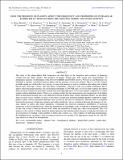Files in this item
Does the presence of planets affect the frequency and properties of extrasolar Kuiper belts? Results from the Herschel DEBRIS and DUNES surveys
Item metadata
| dc.contributor.author | Moro-Martín, A. | |
| dc.contributor.author | Marshall, J.P. | |
| dc.contributor.author | Kennedy, G. | |
| dc.contributor.author | Sibthorpe, B. | |
| dc.contributor.author | Matthews, B.C. | |
| dc.contributor.author | Eiroa, C. | |
| dc.contributor.author | Wyatt, M.C. | |
| dc.contributor.author | Lestrade, J.-F. | |
| dc.contributor.author | Maldonado, J. | |
| dc.contributor.author | Rodriguez, D. | |
| dc.contributor.author | Greaves, J.S. | |
| dc.contributor.author | Montesinos, B. | |
| dc.contributor.author | Mora, A. | |
| dc.contributor.author | Booth, M. | |
| dc.contributor.author | Duchêne, G. | |
| dc.contributor.author | Wilner, D. | |
| dc.contributor.author | Horner, J. | |
| dc.date.accessioned | 2015-03-25T17:01:02Z | |
| dc.date.available | 2015-03-25T17:01:02Z | |
| dc.date.issued | 2015-03-10 | |
| dc.identifier | 176731422 | |
| dc.identifier | a91c6d7e-d72a-4fa9-90d0-fd5002992836 | |
| dc.identifier | 84924690235 | |
| dc.identifier | 000350965500072 | |
| dc.identifier.citation | Moro-Martín , A , Marshall , J P , Kennedy , G , Sibthorpe , B , Matthews , B C , Eiroa , C , Wyatt , M C , Lestrade , J-F , Maldonado , J , Rodriguez , D , Greaves , J S , Montesinos , B , Mora , A , Booth , M , Duchêne , G , Wilner , D & Horner , J 2015 , ' Does the presence of planets affect the frequency and properties of extrasolar Kuiper belts? Results from the Herschel DEBRIS and DUNES surveys ' , Astrophysical Journal , vol. 801 , no. 2 . https://doi.org/10.1088/0004-637X/801/2/143 | en |
| dc.identifier.issn | 0004-637X | |
| dc.identifier.uri | https://hdl.handle.net/10023/6331 | |
| dc.description | G.K. and M.C.W.'s work was supported by the European Union through ERC Grant 279973. C.E. and B.M. are partially supported by Spanish Ministry of Economy Grant AYA 2011-26202. D.R.R. acknowledges support from Chilean FONDECYT Grant 3130520. M.B. acknowledges support from a FONDECYT Postdoctoral Fellowship, Project 3140479. | en |
| dc.description.abstract | The study of the planet-debris disk connection can shed light on the formation and evolution of planetary systemsand may help "predict" the presence of planets around stars with certain disk characteristics. In preliminary analyses of subsamples of the Herschel DEBRIS and DUNES surveys, Wyatt et al. and Marshall et al. identified a tentative correlation between debris and the presence of low-mass planets. Here we use the cleanest possible sample out of these Herschel surveys to assess the presence of such a correlation, discarding stars without known ages, with ages Gyr, and with binary companions AUto rule out possible correlations due to effects other than planet presence. In our resulting subsample of 204 FGK stars, we do not find evidence that debris disks are more common or more dusty around stars harboring high-mass or low-mass planets compared to a control sample without identified planets. There is no evidence either that the characteristic dust temperature of the debris disks around planet-bearing stars is any different from that in debris disks without identified planets, nor that debris disks are more or less common (or more or less dusty) around stars harboring multiple planets compared to single-planet systems. Diverse dynamical histories may account for the lack of correlations. The data show a correlation between the presence of high-mass planets and stellar metallicity, but no correlation between the presence of low-mass planets or debris and stellar metallicity. Comparing the observed cumulative distribution of fractional luminosity to those expected from a Gaussian distribution in logarithmic scale, we find that a distribution centered on the solar system's value fits the data well, while one centered at 10 times this value can be rejected. This is of interest in the context of future terrestrial planet detection and characterization because it indicates that there are good prospects for finding a large number of debris disk systems (i.e., with evidence of harboring planetesimals, the building blocks of planets) with exozodiacal emission low enough to be appropriate targets for an ATLAST-type mission to search for biosignatures. | |
| dc.format.extent | 670596 | |
| dc.language.iso | eng | |
| dc.relation.ispartof | Astrophysical Journal | en |
| dc.subject | Circumstellar matter | en |
| dc.subject | Infrared stars | en |
| dc.subject | Interplanetary medium | en |
| dc.subject | Kuiper Belt: general – planet–disk interactions | en |
| dc.subject | Planetary systems | en |
| dc.subject | QC Physics | en |
| dc.subject | 3rd-DAS | en |
| dc.subject.lcc | QC | en |
| dc.title | Does the presence of planets affect the frequency and properties of extrasolar Kuiper belts? Results from the Herschel DEBRIS and DUNES surveys | en |
| dc.type | Journal article | en |
| dc.contributor.sponsor | Science & Technology Facilities Council | en |
| dc.contributor.institution | University of St Andrews. School of Physics and Astronomy | en |
| dc.identifier.doi | 10.1088/0004-637X/801/2/143 | |
| dc.description.status | Peer reviewed | en |
| dc.identifier.grantnumber | ST/J001651/1 | en |
This item appears in the following Collection(s)
Items in the St Andrews Research Repository are protected by copyright, with all rights reserved, unless otherwise indicated.

